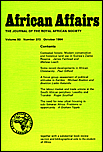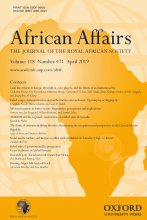Resource information
Was the civil war in Sierra Leone (1991-2002) fought for diamonds, or was it a peasant insurgency motivated by agrarian grievances? The evidence on both sides is less than conclusive. Ibis article scrutinizes the peasant insurgency argument via a more rigorous methodology. Hypotheses concerning intra-peasant tensions over marriage and farm labour are derived from an examination of the anthropological literature. These are tested using econometric tools, applied to data from a randomized survey of 2,239 households in 178 villages surrounding the Gola Forest in eastern and southern Sierra Leone, the cradle of the war. It is shown that a decade after the war ended peasant disputes over marriage continue to mark out an incipient class divide in isolated rural communities, as evidenced by cases presented in local courts and family moots. Disputes mainly involve a village elder suing a young man with weak social protection. Fines are exceptionally high, and mostly paid off in the form of coerced farm labour. It is argued that grievance over this long-standing form of labour exploitation fed insurgency, and contributed to the otherwise puzzlingly high levels of peasant-uponpeasant violence associated with the war in Sierra Leone.



